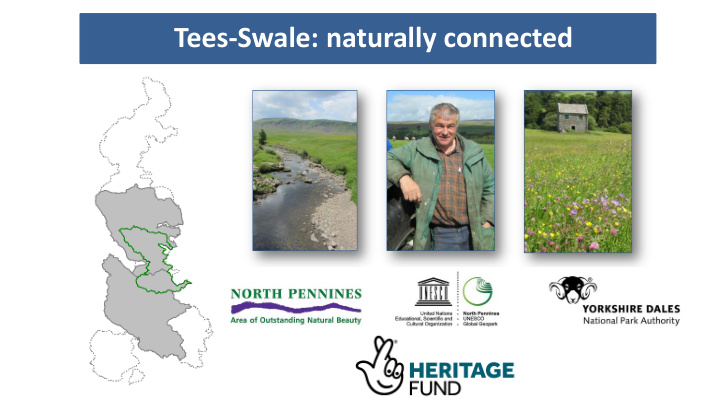



Tees-Swale: naturally connected
Project area Tees-Swale project area 829 sq km
Project rationale “More, bigger, better and joined up” “The first priority is to enhance the quality of remaining wildlife habitat”
Project rationale The northern Pennines have the lowest levels of habitat fragmentation/ highest levels of habitat connectivity in England Planning for Biodiversity – opportunity mapping and habitat networks in practice. Catchpole. 2006
Project area Priority habitat – 502 sq km (61%) Blanket Bog & Valley Mire – 400 sq km (48%) Upland & Lowland Hay Meadows – 14 sq km (2%) NB: the ‘white’ areas support important populations of breeding birds, including priority species such as curlew, lapwing & black grouse
Project area SSSI – 67% of project area (553 sq km) 86% Priority habitat inside SSSI (431 sq km) 14% Priority habitat outside SSSI (70 sq km)
Project rationale HNV farming is critical for upland habitats / biodiversity Farming community is central to Tees-Swale Trying to create transformation and lasting change
Project themes Nature Improvement Training and Skills Access and Engagement
Nature Improvement – habitat works Peatland restoration 500ha Woodland creation 200ha Wetland creation 40 sites Hay meadow restoration 200ha Diffuse metal mitigation 300km of watercourse Rush management 2000ha River enhancement 1 location currently
Nature Improvement 100 farmers / landowners directly engaged 1 to 1 1/3 of the farmers in the project area
Farmer areas of interest
Events and Cluster Development • Demonstration events • Cluster development • Facilitation Fund group
Identifying and costing habitat works • Working with farmers to agree Habitat Year 1 Year 2 Year 3+ works for years 1 and 2 Species rich grassland >65ha >65ha >50ha Rush control >180ha >100ha >60ha • Opportunities for further work Wetlands/scrapes ~12 ~9 in years 3+ also identified. Woodland creation >50ha >40ha >40ha
Kexwith • Originally outside of the boundary. • Sue and Ray are interested in farming for wildlife and habitats • Hit by the floods at the end of July.
Hawes Auction mart 18 th Sept 2018
Species-rich meadows • Five ‘Yorkshire Fog meadows’ surveyed • The most species rich meadow put forward for restoration • Potential for more to be restored in the future.
Rush pasture and scrape creation • Good habitat for breeding waders. • Farmer to install scrape with guidance from team and RSPB. • May need rush management in the future, year 3?
Woodland planting • Interested in some woodland planting • Will support with under-planting in Lockey Wood • Choice of funding, could be Countryside Stewardship and Tees-Swale combination or solely funded by Tees-Swale.
Hill Gill, Charlie & Gina Parker • Initial farmer interview in February 2019 • Has native breed cattle, sheep, goats and ponies • View themselves as “temporary custodians” and aim to “leave land in better health than when they came there”
Habitat Works
Training and Skills Farmer/conservationist knowledge-exchange Farmer-led habitat assessment Alternatives to intensification Contractor training Volunteer training
Training and Skills 16 Traineeships
Access and Engagement Engaging with groups around the area, generating new audiences 19 new routes and trails / enhancements Interpretation Community-led art in the landscape New partnership with outdoor education centres e.g. Marrick Priory
Delivery phase staffing 1 Project Manager 3 Land Management Facilitators* 1 2 Engagement Officers* 1 0.6 Access Officer 0.5 Comms Support 0.5 Interpretation 1 Finance Officer (p/t) 1 Admin Officer (p/t)
Timescale Submission 2 nd March 2020 Decision – Late June 2020 Delivery to mid 2025
Tees-Swale: naturally connected
Recommend
More recommend